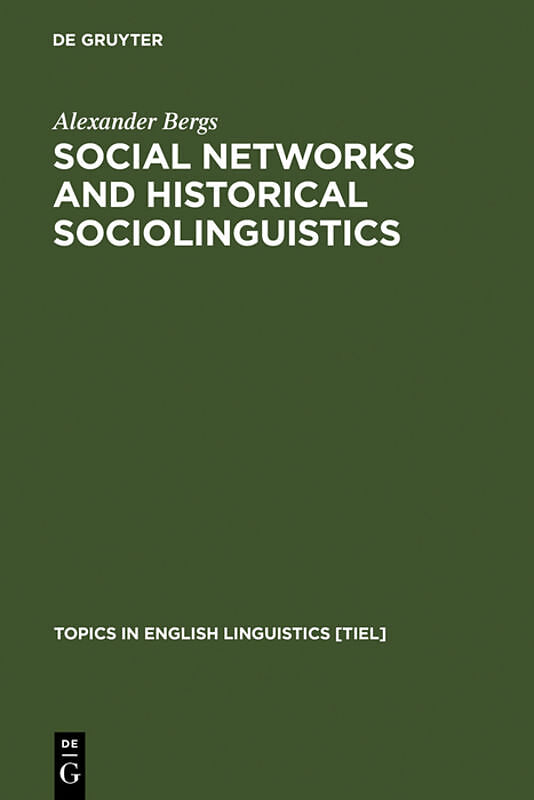Social Networks and Historical Sociolinguistics
Einband:
Fester Einband
EAN:
9783110183108
Untertitel:
Studies in Morphosyntactic Variation in the Paston Letters (1421-1503)
Autor:
Alexander Bergs
Herausgeber:
De Gruyter Mouton
Auflage:
Reprint 2011
Anzahl Seiten:
332
Erscheinungsdatum:
16.02.2005
ISBN:
3110183102
The book presents an analysis of selected domains of morphosyntactic variation in a 250,000 word collection of the Middle English Paston Letters (1421-1503) from a historical sociolinguistic point of view. In the three case studies, two nominal and one verbal variable are described and discussed in detail: the replacement of Old English pronouns by borrowed pronouns, the introduction and spread of the relativizers, and the spread and routinization of light verb constructions (take, make, give, have, do plus deverbal noun). While the study aims at a balanced integration of theories and methods from a number of different approaches in sociolinguistics, cognitive linguistics, typology, and language change, its main focus is social network theory and the role of the linguistic individual in the formation and change of language structures. Questions of individual language use and of deliberate versus unmonitored changes in the (individual) system take center stage and are discussed in the light of social network analysis. Traditional empirical social network analysis is carefully revised. Despite its many merits in present-day sociolinguistics, it often needs to be supplemented by hermeneutic-biographical analyses of the individual speakers' lives when applied to historical data. With this background, common theories and models of language change, such as grammaticalization, paradigmatic pressure, typological alignment, and generational shifts, are illustrated and evaluated from the point of view of single speakers and social groups, and their particular embedding in the speech community through various network structures. The book is of interest to advanced students and researchers in English and general linguistics, Middle English, historical linguistics and language change, corpus linguistics, as well as sociolinguistics.
Autorentext
Alexander T. Bergs is Assistant Professor at the Department of English Language and Linguistics at Heinrich-Heine-University, Düsseldorf, Germany.
Zusammenfassung
"Any researcher interested in these variables should read this book, because they are discussed from a wide variety of theoretical and analytical perspectives and, importantly, discrepancies between the results of this work and the results obtained from these earlier studies should now be taken into account. In addition, the methodological and theoretical contexts of the analyses are put together in what might almost be called a hidden agenda of the book, which seems to be an effort to question our techniques and refine our understanding of the processes involved in language change..."
Margaret Sonmez in: Linguistlist 2005
Inhalt
Chapter One Introduction1. Aims and contents1.1. Empirical objectives, historical embedding1.2. Structure of the book Chapter TwoHistorical sociolinguistics1. What is historical sociolinguistics?1.1. Social sciences - history - linguistics1.2. Historical sociolinguistics1.2.1. The object of investigation1.2.2. Research material2. Summary Chapter Three Social network analysis - present and past1. Introduction2. Present-day social network analysis2.1. The development of network theory2.1.1. Elements and constructs of network theory2.1.2. Attitudes and behavior in networks - network roles3. Social network analysis, language variation, and language change3.1. Principles of language change3.2. Historical network analysis3.2.1. Background3.2.2. The principle of uniformity3.2.3. Data problems3.3. Micro- versus macro-studies3.4. Developing a network for (late) medieval England3.5. The network(s) of the Paston family3.5.1. Biographical sketches3.5.2. The network(s)4. The corpus Chapter Four Personal pronouns1. The development of personal pronouns in Middle and Early Modern English1.1. Sources: Dialect geography1.2. Sources: Internal factors1.2.1. Therapeutic change in the pronoun system1.2.2. Analogy1.2.3. Formatives and analogical leveling1.2.4. Frequency and analogy2. Pronouns in the Paston Letters2.1. Overall developments2.2. Distribution across time2.3. Individual patterns2.4. External factors2.4.1. Gender of the speaker2.4.2. Addressee and relationship to addressee2.5. Internal factors2.5.1. Syntactic function2.5.2. Gender of the referent2.5.3. Animacy of the referent2.5.4. Stress and phonetic environment2.6. Summary3. Ye and You Chapter 5Relative clauses1. Introduction2. Relativization - some technical remarks2.1. Adnominal - free - sentential2.2. Restrictive - non-restrictive3. Relativization and the history of English3.1. Relativization in the Old English Period3.2. Changes in the Late Old English and Early Middle English Period3.3. Relative clauses after 13004. Relative Clauses in the Paston Letters4.1. Methodology4.1.1. Relative marker type4.1.2. Restrictiveness4.1.3. Syntactic function of the relativizer and antecedent4.1.4. Animacy4.1.5. Number4.1.6. Definiteness4.1.7. Distant versus adjacent relative clauses5. Results5.1. A community grammar5.1.1. Restrictiveness5.1.2. Animacy5.1.3. Definiteness of the antecedent5.1.4. Number5.1.5. Syntactic function5.1.6. Distance antecedent - relative clause5.2. A social grammar5.2.1. Gender of the author5.2.2. Gender of the addressee5.2.3. Relationship between author and addressee5.2.4. Variation across time5.3. Individual grammars5.3.1. Individual use of relative pronouns6. Summary Chapter 6The light verb construction1. Introduction1.1. Historical development1.1.1. Structural changes and developments1.2. The light verb construction in the Paston Letters1.2.1. Methodological issues2. Results2.1. General frequencies2.1.1. Number, determination, modification2.1.2. Syntax2.2. Social factors and developments2.2.1. Temporal factors2.2.2. Gender2.3. Individual grammars Chapter 7Conclusion: A network perspective1. A historical whodunnit1.1. Personal pronouns, relativizers, and light verb constructions1.2. Corroborative data2. Networks and language use in the Paston Family: Take One2.1. Why network strength scales should not simply correlate with historical linguistic data - at least in this case2.1.1. Now you see it, now you don't2.1.2. The times they are achanging - and so are the networks2.2. Networks and language use in the Paston family: Take Two3. Social networks and language use: a modest proposal

Leider konnten wir für diesen Artikel keine Preise ermitteln ...
billigbuch.ch sucht jetzt für Sie die besten Angebote ...
Die aktuellen Verkaufspreise von 6 Onlineshops werden in Realtime abgefragt.
Sie können das gewünschte Produkt anschliessend direkt beim Anbieter Ihrer Wahl bestellen.
Loading...
Die aktuellen Verkaufspreise von 6 Onlineshops werden in Realtime abgefragt.
Sie können das gewünschte Produkt anschliessend direkt beim Anbieter Ihrer Wahl bestellen.
| # | Onlineshop | Preis CHF | Versand CHF | Total CHF | ||
|---|---|---|---|---|---|---|
| 1 | Seller | 0.00 | 0.00 | 0.00 |
